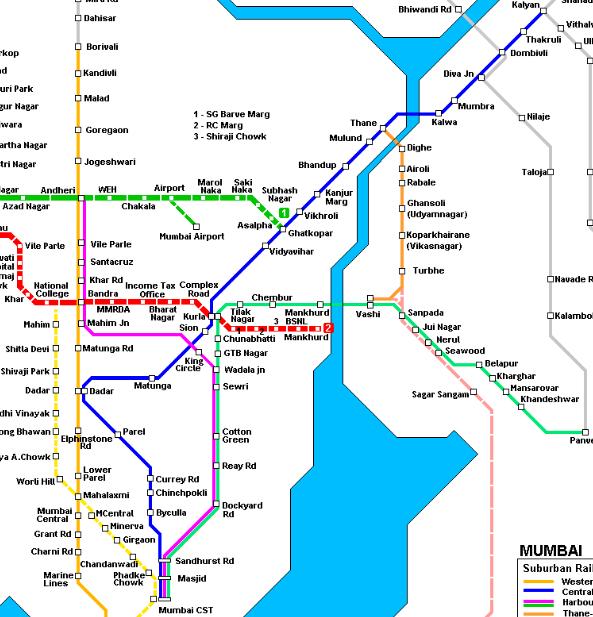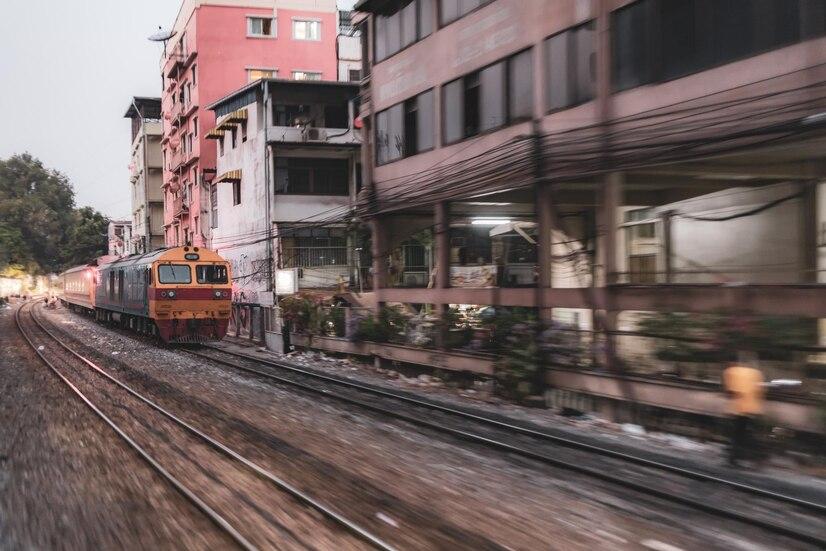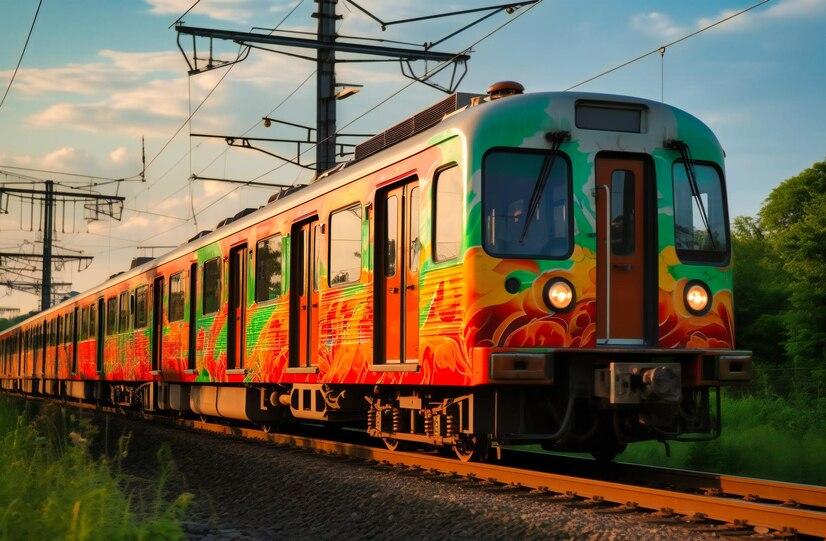



Table of Contents
- History of Mumbai Local Central Line
- Route of Central Line, Mumbai
- Map of Central Line Mumbai
- Stations in Central Line, Mumbai
- List of Mumbai Central Line Stations
- Interchange Points on Central Line Mumbai
- Central Line Mumbai Train Timings
- Fast and Slow Trains
- Central Line Mumbai Fares
- Contact Details : Central Line Mumbai
- Faq's
History of Mumbai Local Central Line
The Central Line of the Mumbai Suburban Railway is one of the most extensive and busiest railway networks in India, serving the city of Mumbai and its suburbs. Having a rich history which dates as far back as 1853, when the first passenger train in India began its journey from Chhatrapati Shivaji Terminus (formerly Bori Bunder) in Mumbai to Thane. The line was extended to Kalyan in 1854 and further expanded to Igatpuri and Khopoli in 1856. Electrification work began in the early 1900s, and the first electric train ran between Victoria Terminus and Kurla on February 3, 1925. Today, the Central Line is one of the vital links that connects the extensive suburban railway network of Mumbai with the various parts of the metropolitan city.
Route of Central Line, Mumbai
The Central Line of Mumbai's suburban railway network stretches across 24 stations, spanning from Chhatrapati Shivaji Maharaj Terminus (formerly Victoria Terminus) to Kalyan Junction, all at ground level. This vital artery features a quadruple track section originating from Chhatrapati Shivaji Maharaj Terminus and extending to Kasara, Roha, Uran, and Khopoli in Maharashtra.
The Central line consists of the following routes:
- CSMT-Kasara
- CSMT-Khopoli
- CSMT-Roha
- CSMT-Uran
Comprising three major corridors, the Central Line branches out into suburban satellite towns, offering both local and through services. From CSMT to Kalyan Junction (55 km), the line divides into two distinct routes: one heading towards Kasara (67 km) in the northeast and the other towards Khopoli (61 km) in the southeast, collectively forming the 'Main' Line. Notably, the Central main line intersects with the Western line at Dadar station. The line operates a mix of DC and dual-powered EMU trains.
Key maintenance facilities for this line are situated at Kurla and Kalva, catering to a fleet of fast and slow locals for suburban commuters. While slow locals make stops at every station, fast locals have selective halts at Byculla, Dadar, Kurla, Ghatkopar, Vikhroli, Bhandup, Mulund, Thane, Diva, Dombivli, and Kalyan Junction. Beyond Kalyan Junction, all services operate at a slower pace, typically commencing and concluding journeys at significant stations along the route.
Also Read : Mumbai Metropolitan Region Development Authority (MMRDA)
Map of Central Line Mumbai
 Source - Pinterest
Source - Pinterest
Stations in Central Line, Mumbai
The Central Line has 24 stations from CSMT to Kalyan Junction, including major stations like Dadar, Ghatkopar, Thane, and Kalyan. The line offers interchange facilities at CSMT, Masjid, Sandhurst Road, Parel, Dadar, Kurla, Ghatkopar, Kanjurmarg, Thane, Diva Junction, Kopar, and Kalyan Junction, allowing passengers to switch between different lines.
Section | Total Stations | Stations |
Main Line | 24 | Chhatrapati Shivaji Maharaj Terminus (CSMT), Byculla, Dadar, Kurla, Ghatkopar, Vikhroli, Bhandup, Mulund, Thane, Diva, Dombivli, Kalyan Junction |
CSMT to Kasara | 11 | Ambivli, Titwala, Khadavli, Vasind, Asangaon, Atgaon, Khardi, Kasara |
CSMT to Khopoli | 12 | Ambarnath, Badlapur, Vangani, Shelu, Neral, Bhivpuri Road, Karjat, Palasdari, Kelavli, Dolavli, Lowjee, Khopoli |
The above table provides an overview of the Mumbai Central Line stations categorised by their respective sections, along with the total number of stations in each section.
List of Mumbai Central Line Stations
A list of all Mumbai Central Line stations, along with those where fast trains make stops:
- Chhatrapati Shivaji Maharaj Terminus (CSMT)
- Masjid
- Sandhurst Road
- Dockyard Road
- Reay Road
- Cotton Green
- Sewri
- Vadala Road
- Kurla
- Chunabhatti
- GTB Nagar
- Wadala
- Dadar
- Matunga
- Sion
- Kurla
- Vidyavihar
- Ghatkopar
- Vikhroli
- Kanjurmarg
- Bhandup
- Nahur
- Mulund
- Thane
- Kalwa
- Mumbra
- Diva Junction
- Kopar
- Dombivli
- Thakurli
- Kalyan Junction
 Mumbai Central Line Stations
Mumbai Central Line Stations- Dadar
- Kurla
- Ghatkopar
- Thane
- Dombivli
- Kalyan Junction
The Mumbai Suburban Railway's main line stretches from CSMT to Kalyan before branching into two corridors, one heading towards Khopoli and the other towards Kasara.
South-east Section
- Vithalwadi
- Ulhasnagar
- Ambernath
- Badlapur
- Vangani
- Shelu
- Neral Junction
- Bhivpuri Road
- Karjat
- Palasdari
- Kelavli
- Dolavli
- Lowjee
- Khopoli
North-east Section
- Kalyan Junction
- Shahad
- Ambivli
- Titwala
- Khadavli
- Vasind
- Asangaon
- Atgaon
- Thansit
- Khardi
- Umbermali
- Kasara
Vasai Road-Bhiwandi-Diva-Panvel-Roha line
- Vasai Road
- Juchandra
- Kaman Road
- Kharbao
- Bhiwandi Road
- Kopar
- Diva Junction
- Dativali
- Nilaje
- Taloja Panchnand
- Navade Road
- Kalamboli
- Panvel
- Branch line starts at Kalyan
Interchange Points on Central Line Mumbai
Station | Connections |
CSMT | Harbour line |
Dadar | Western line |
Kurla | Harbour line |
Ghatkopar | Metro Line 1 |
Kanjurmarg | Metro Line 6 |
Thane | Trans-Harbour line |
Diva Junction | Vasai Road - Roha line |
Kalyan Junction | Kasara and Khopoli |
Central Line Mumbai Train Timings
The Central Line of Mumbai's suburban railway network operates on a precise and extensive timetable, catering to the bustling needs of the city's commuters. With trains running from the early hours of the morning until late at night, the Central Line ensures seamless connectivity for millions of passengers traversing the length and breadth of Mumbai and its surrounding suburbs. During peak hours, which typically coincide with the morning and evening rush, trains are scheduled at frequent intervals to accommodate the high volume of commuters traveling to and from work, educational institutions, and various other destinations across the sprawling metropolis.
Beyond the peak hours, the Central Line maintains a consistent schedule throughout the day, offering commuters a reliable mode of transportation for their daily activities. Whether it's for running errands, attending appointments, or simply exploring the vibrant cityscape, passengers can rely on the punctuality of Central Line trains to reach their destinations efficiently. Additionally, the Central Line caters to the diverse needs of its passengers by offering both fast and slow services, providing commuters with flexibility and convenience in their travel options. With its well-organised timetable and dependable services, the Central Line plays a pivotal role in keeping Mumbai on the move, serving as a lifeline for the city's residents and visitors alike.
Fast and Slow Trains
Fast trains are designed to cover longer distances with fewer stops, making them ideal for passengers traveling between major stations or across different regions of the city. These trains offer a quicker commute, reducing travel time significantly and allowing commuters to reach their destinations in a more time-efficient manner. Fast trains typically make stops only at major junctions or key stations along the route, minimizing interruptions and maximizing the speed of travel.
On the other hand, slow trains serve as the backbone of the Central Line's transportation network, stopping at every station along the route. While they may take longer to reach their final destinations compared to fast trains, slow trains provide essential connectivity to the numerous neighborhoods and suburbs nestled within Mumbai's urban sprawl.
These trains offer a more localized service, allowing passengers to embark and disembark at various stations throughout the city, facilitating seamless travel for both short and medium-distance journeys. By offering a combination of fast and slow services, the Central Line ensures that commuters have access to a diverse range of travel options, enabling them to navigate Mumbai's bustling metropolis with convenience and efficiency.
 Mumbai Local Fast trains are designed to cover longer distances with fewer stops
Mumbai Local Fast trains are designed to cover longer distances with fewer stops
Central Line Mumbai Fares
The Mumbai suburban railway system follows a zonal fare structure, particularly on the Central line, where fares vary depending on the number of zones crossed during the journey. With first-class tickets ranging from Rs 50 to Rs 245, and second-class tickets from Rs 5 to Rs 35, passengers pay differing amounts based on the distance traveled. For regular commuters, monthly passes are available, offering cost-effective solutions tailored to the length of their daily commute.
Monthly pass options include a first-class AC local pass from CSMT to Byculla priced at Rs 620, while a first-class regular local pass costs Rs 345. This fare structure ensures that passengers have access to affordable and convenient travel options suited to their individual needs and preferences.
Contact Details : Central Line Mumbai
For any inquiries or grievances, please feel free to contact the Chhatrapati Shivaji Maharaj Terminus at 022 22621450.
In conclusion, the Central Line of Mumbai's Suburban Railway showcases the city's bustling energy and relentless progress. With a rich history dating back to India's first passenger train in 1853, it has evolved into a vital lifeline for millions of commuters, seamlessly connecting Mumbai and its suburbs. Its extensive route, diverse timetable, and affordable fare structure ensure convenient travel options for all passengers, reflecting its commitment to accessibility and efficiency. As the heartbeat of Mumbai's transportation network, the Central Line continues to play a pivotal role in shaping the city's dynamic landscape, connecting communities and driving progress every day.
explore further
Latest from Editorials
More from Publications
Resources
Dwello, for every home buyer, is a way to go from 'I feel' to 'I know', at no extra cost.




